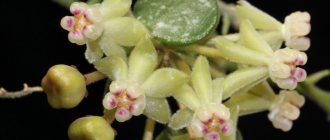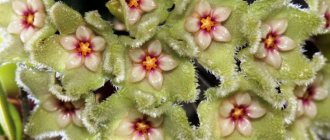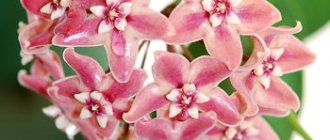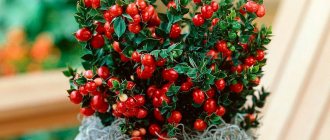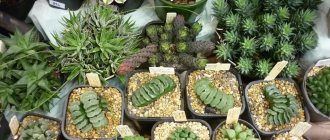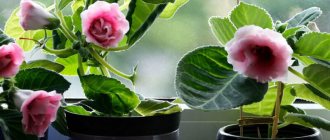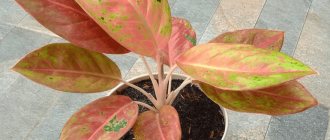What does hoya look like and bloom in its natural environment?
In summer, hoya blooms with fragrant, porcelain-white, pinkish, yellow-greenish and other shades of bisexual flowers, collected in umbrella inflorescences. Both the botanical description of the flowers of the Hoya plant and numerous photographs confirm that they have a star-shaped appearance, consist of petals and a central five-membered crown rising above them. The average diameter of flowers is from 1 to 2 cm, except for the majestic appearance (8 cm).
While the hoya plant is blooming, a pleasant perfume aroma prevails around the bush or vine. Representatives of certain species are even able to secrete nectar, which is attractive to many insects.
In its natural environment, the plant can reach 10 meters in length. Young shoots are immediately colored brown-violet, and as they mature, they acquire a rich green tint, and then gradually become lignified. The foliage is fleshy, oval, with a pointed apex. The average length of the leaves is from 5 to 15 cm, width - from 3 to 8 cm. Both the color and the leaves are dense, have a matte appearance, which gives the visual impression that they are cast from wax.
Familiarize yourself with some types and varieties of hoya from photos with official names to get a general impression of the plant before getting acquainted in detail:
What it looks like, what family it belongs to
The culture is a representative of evergreen vines of the Kutrov family, the Lastovnevy subfamily.
The foliage of the plant is double-sided: the back is shiny, and the front is matte. The leaf grows up to 6 cm in length and up to 2.5 cm in width. Initially they are reddish-brown in color, then become dark green.
Hoya lacunosa
The stems are greenish in color with a reddish undertone and are represented by numerous vines. 15-20 inflorescences with a white or pinkish color are located on thin branches. The aroma from the buds intensifies in the evening.
The plant has been cultivated at home since 1826. New varieties have variegated rather than classic green foliage.
Attention! The culture is not recommended to be grown in homes with animals and small children, because hoya is poisonous
Common varieties
The description indicates the following varieties:
- Tove - with a miniature size, the foliage is colored purple. The inflorescences have a cream tone and a yellowish core. The diameter of the buds is up to 6 mm.
- Snow Caps - Silvery foliage grows up to 5cm long and 2cm wide. The flowers are snow-white, up to 10 mm in diameter. Refers to slow growing varieties.
- Hoya Eskimo (hoya escimo) - with diamond-shaped glossy foliage, on which greenish-silver spots are randomly located. Hoya lacunosa eskimo has the snow-white buds that are standard for this subspecies. If a silver tint predominates on the leaves, then the prefix “super” or “silver” is added to the main name.
- Royal flash - characterized by dark bronze foliage with small silver spots. The buds of Royal Flash (flush) are white, while the young growth has a brownish-reddish tint.
Important! A distinctive feature of the variety is its smell - during the day it resembles cloves, and at night it resembles incense.
Hoya lacunosa popsicle silver
Is it possible to keep hoya at home and the qualities of wax ivy
Many cultivars are grown indoors. This plant has decorative qualities and is often used for landscaping offices and offices. There are a large number of legends and superstitions regarding the issue of growing Hoya at home, many of which, oddly enough, contradict each other.
For example, according to one belief, this flower “expels” men from their homes (husband, sons). According to other legends, culture is able to pacify resentment and envy. Still other sources, when asked whether it is possible to keep hoya or wax ivy at home, say that this plant is a source of happiness in the family, so the ideal place for growing it is the marital bedroom.
Which version to take into account is an individual decision of the gardener. But whatever the choice, it will not cancel the fact that exotic flowers can captivate everyone with their beautiful color, even the most demanding florist.
Wax ivy propagation
When studying information on the topic - hoya: care and propagation, you need to know that layering, cuttings or seeds are used to propagate the plant. In the first case, you can count on flowering of young specimens in the year of planting. At the same time, the cutting method is considered the easiest and most reliable.
The use of the seed method will be justified if it is necessary to carry out breeding work.
Cuttings of indoor Hoya
Rooting occurs at a temperature of at least + 22 ° C, high air humidity. After 2 weeks, the cuttings with roots appearing will be ready for transplanting. Also, cuttings for rooting can be placed in a moist substrate or sphagnum moss.
Crop propagation by layering
A branch of an adult hoya is cut slightly, wrapped in moistened moss, and covered with plastic film. When such a shoot has roots, it is separated from the mother wax ivy and placed in a personal flowerpot.
Sowing Hoya Seeds
This method is considered the most labor-intensive. It will take about 90 days for the sown seeds to germinate and the first leaves to form on young plants. It is worth taking into account that seed material is extremely rare on sale. Obtaining seeds from available plants is incredibly difficult. This method is practiced only by extremely experienced specialists - professional florists.
Popular types and varieties of indoor hoya plants: photos, names and descriptions
Today, approximately 200 species of hoya plant are known. For growing indoors, the most popular among them are:
Noua bella (hoya beautiful).
Noua carnosa (hoya fleshy).
The following types of this plant are cultivated much less frequently at home:
Hoya imperialis (majestic hoya).
Hoya longifolia (long-leaved hoya).
Hoya lacunosa (hoya concave)
Hoya pubicalyx (fuzzy cup hoya).
Hoya kerrii (Hoya Kerry).
Hoya multiflora (multiflorous hoya).
The type of hoya called beautiful is a low-growing, branched evergreen shrub, covered with small foliage (reaches a length of about 3 cm) and having drooping shoots (their length varies from 30 to 50 cm). The leaves have a fleshy structure, lanceolate-ovate shape, and a convex surface. The foliage on the shoots grows very densely. The flowers resemble small stars in appearance, the color of the petals is white and the core is crimson. The color is collected in umbrellas, each of which has from 7 to 9 “stars”.
Compare the description of the beautiful Hoya species with the photos below:
This is an epiphytic plant; in nature, its usual habitat is tree branches in tropical forests. In indoor conditions, it is grown as a hanging crop.
Within the species Noua bella, many bush-type varieties have been bred. The main difference between them is the color of the leaves.
Description of the variety
One of the most common Hoya species is Hoya carnosa. The thick, hard leaves appear to be covered with wax, hence other names: waxy hoya or wax ivy (although it is a vine and not related to ivy).
Some varieties are variegated (variegated). These include the Tricolor variety (Hoya tricolor). The leaves, initially white and pink, gradually turn green at the edges and the middle becomes yellow or reddish. Young shoots have a purple tint.
The flower shape is typical of Hoya: a small five-pointed star. Each consists of two stars:
- lower - flesh-colored corolla (larger in size);
- the top one is a bright red crown.
25-30 flowers are collected in clusters. Flowering is long-lasting (about six months), starting in April. The aroma is strong and sweet.
In home floriculture they use both climbing (in one long stem) and ampelous (in several shorter shoots).
Bush varieties of hoya and vines
Hoya bella var. Louis Buis is a beautiful hoya bush variety with leaves that have golden spots in the center and a reddening midrib in good light conditions.
Hoya bella Variegata is a plant with foliage with a thin edging of white or yellowish tint.
Hoya bella Wee is a variety of beautiful hoya with especially small leaves, which are placed in a whorl not in twos, as usual, but in threes.
Hoya fleshy has become widespread due to its unpretentiousness to growing conditions and ease of care. Unlike the previous species, this is not a bush plant, but an evergreen climbing vine.
Its length can be 6 m, so when growing a crop you should take care of support. The foliage of the plant is oval, thick, hard, dark green, has a shiny surface, reaches about 8 cm in length. The inflorescences are umbrellas, which contain 20 flowers with a strong, pleasant aroma. The main color of the petals is white, with a pink crown located in the central part.
Evaluate in the photo what varieties and varieties the fleshy Hoya has:
The images show those that are most popular in home gardening.
Hoya carnosa Variegata (hoya variegata) , in particular its variety called "Crimson Queen", which is famous for its unusually delicate cream-colored edging along the edges of its rich green leaves.
Hoya carnosa Tricolor (Hoya tricolor) and its variety with the original name “Exotic”, which is loved by many professional and amateur gardeners thanks to its scarlet flowers and green-pink-cream foliage.
The majestic hoya flower is also a climbing vine. It is densely dotted with lanceolate-oval foliage, the length of which reaches 15 cm and the width - up to 8 cm. The color of this plant is considered the largest among the known species: the diameter of the flowers is 8 cm. The peduncles are long, flower umbrellas are formed on them, in each of which contain from 8 to 10 smooth star-shaped flowers with deep red petals and a white central crown.
On the reverse side, the petals are decorated with an admixture of green or yellow. Hoya imperialis is widely known for its pleasant perfume scent.
Descriptions of popular varieties of this type of hoya with photos and official names are presented below - study and choose the green “pet” that is most suitable for your greenhouse:
Hoya imperialis var. rauschii features wavy-edged foliage and white-green flowers with pink and purple hues.
Hoya imperialis "Borneo Red" is popular because it grows very quickly and has purple flowers with a fruity, sweet scent.
Hoya imperialis var . Palawan is famous for its yellow-golden flowers with an original slightly reddish tint.
The photo below shows Hoya longifolia:
This is a climbing plant, the thin shoots of which contain a large amount of milky sap. The liana is densely dotted with lanceolate-shaped foliage, smooth edges, rich green color, and a fleshy structure without visible veins. The length of each leaf is approximately 13 cm and the width is about 2 cm.
The surface is without pubescence and is not shiny. Fragrant flowers in quantities from 5 to 12 pieces are collected in a spherical umbrella. The diameter of each flower varies from 1.5 to 1.7 cm, and there is pubescence on the surface. The color of the petals is white, the central crown is pale pink or pure white.
Find out what long-leaved hoya looks like in colorful photos.
Concave Hoya is an epiphytic plant, very branched, with flexible branches that look like very densely growing cascading lashes. The foliage is diamond-shaped, thickened, with edges turning inward, and rich green in color. The length of each leaf does not exceed 6 cm. The inflorescence is an umbrella, shaped like a fluffy ball. One umbel contains 15 to 20 fuzzy white or cream flowers with a white crown topped with a yellow center.
Read the description of popular varieties of concave hoya with photos below:
“Tova” is a hybrid with monochromatic foliage and a light green color.
"Eskimo" is a cultivar with leaves decorated with a marble pattern of a lighter shade.
Popular varieties
The following varieties are in great demand among gardeners.
Kerry
Hoya carnosa - home care
Hoya Kerry, or Valentine (hoya in love), gets its name due to the shape of the leaf, which resembles a heart. To prevent hanging plant species from toppling over, the stems must be constantly tied up. The length of hard leaves can reach about 15 cm.
Kerry flowers are pubescent and collected in spherical umbels. The color directly depends on the amount of light in the room where the plant grows. The color of the flower changes as the amount of light changes.
Note! As the flowers begin to wilt, their color becomes darker, reaching deep pink and red as a result of the dark-colored nectar.
Hoya Kerry
Bella
Bella is a true shrub with hanging shoots with small ovoid leaves. The flowers are perfect and seem like a real work of art. White stars with a purple crown are collected in small umbrellas. Depending on the variety, Hoya Bella leaves can be green or variegated.
Bella
Fleshy
Hoya fleshy, or Hoya carnosa, is a climbing evergreen plant that can reach a height of up to 6 m, so it requires support when grown. Its flowers are fragrant, white in color and have a pink crown in the very center. The leaves are oval, small, covered with a waxy coating.
Hoya fleshy is the most popular vine among lovers of exotic houseplants. There are several varieties - Crimson Queen, Tricolor, Compacta.
Compacta
Multiflora
Hoya Multiflora is a climbing species. The leaves have an oblong shape. Multiflora inflorescences are yellow. A peculiarity during flowering is that the petals have arched spurs.
Multiflora
Matilda
An attractive type of wax ivy - Matilda. It differs from its relatives in its small size. The leaves are variegated with small specks. Hoya Matilda blooms white with a greenish tint. The core of the flower is red. They are up to 2 cm in diameter. They produce nectar well and love plenty of sunlight. In order for the plant to always delight with its flowers, it is necessary to provide additional lighting. In winter, daylight hours should be about 14-15 hours.
Hoya Matilda
Lacunosa
A species of Hoya with diamond-shaped leaves colored dark green. They have a glossy sheen. The leaf blade of Hoya Lacunosa has small whitish-silver dashes. The flowers are white with yellow in the middle. During the flowering process it emits a delicate aroma. Lacunosa smells like an elegant feminine perfume.
Lacunosa
Vayeti
Elegance and tenderness - all this is about Hoya Vayeti. It comes from the Philippines, but the vine is excellent for growing at home in hanging pots. An ampelous plant with long vines, sometimes reaching more than 10 m in length, must be pinched regularly. The twisting stems form aerial roots. The flowering period is long. It is not advisable to move the pot with the plant from one place to another during this period, as it may react by dropping flower stalks.
Vayeti
Locky
Hoya Lokki is an overseas beauty named after a botanist from Vietnam. It is very similar to its relative, Hoya Multiflora, but at the same time much more graceful. Blooms constantly and profusely in white. The blossoming flowers exude the aroma of caramel. Some gardeners compare the aroma of Hoya Lokki with the smell of chocolate.
Locky
Gracilis
The Filipino princess or beauty from Sulawesi is Hoya Gracilis. A plant with pubescent leaves. Unusual-looking hoya has nodules on the stem, from which several leaves appear at once, creating a kind of mat. When the leaves are exposed to sunlight, the leaves begin to turn pink. The resulting stains become very contrasting.
For your information! The Philippines or Sulawesi are considered the homeland of Hoya graceful.
Gracilis
Obowata
Obowata is a tropical hoya. It grows wild in areas of Indonesia, Thailand and India. Prefers humid regions. The discovery of this species occurred at the end of the 19th century, and only at the beginning of the 20th century. the plant was brought to Europe, so it is little studied.
Obowata
Obscura
During the flowering process, Hoya Obscura has an unusually pleasant aroma, reminiscent of vanilla. The smell is similar to the aroma of blooming lilies. This type of wax ivy has no more than 2-3 leaves on its shoots. Together they create a carpet effect. The peduncle produces 20 to 25 small flowers that resemble stars.
The leaf of Hoya Obscura is narrow, slightly compressed laterally. In this regard, this type of hoya has a name - compressed. It was discovered in the wild back in the 18th century, but was developed into a separate species much later.
Obscura
Hoya Retuza
Rare plant - Retuza. It is so unusual and beautiful that it is the dream of many gardeners. Ampelous hoya has thin shoots of a green hue with crimson colors. Over time, as the plant matures, the inclusions become gray in color.
It grows wild in Indonesia and India. The leaves of this species are thin and long and have an unusual color. The flowers reach 1.5 cm in diameter, gathering into an umbrella.
Retuza
Publicix
Hoya pubicalix is a tropical variety of evergreen wax ivy. It grows wild on the coasts of Australia, India and some areas of southern Asia. Hoya Pubicalix is easy to care for and enjoys long-lasting flowering.
Publicix
Undulata
The Indonesian Peninsula and Kalimantan are considered the homeland of Hoya Undulata. This species grows at an altitude of over 350 m above sea level. The edge of the leaf of this variety is wavy, due to which it received its second name, Hoya wavy.
Undulata
Among the variety of hoya species, plant growers are sure to find something unusual. All hoyas are unpretentious, but they should create the conditions that are inherent in their natural growth. Being tropical representatives, these vines prefer a humid climate. It is important to remember that when the peduncle appears, it is not recommended to touch the plant to avoid dropping the flowers.
How to properly care for Hoya at home
Caring for a hoya flower at home is generally not difficult and will not take much time, since the plant is considered not capricious. For a green “pet,” a well-lit location is suitable. The plant is tolerant of direct sunlight. Although caution in this regard will not hurt: due to exposure to direct ultraviolet radiation, burns may occur on the hoya. To prevent such a disastrous outcome, it is recommended to provide diffused light for the flower at noon by shading the window in one of the following ways:
- Tracing paper.
- Tulle.
- Marley.
An eastern or western window sill is well suited for growing hoya flowers at home. You cannot place the plant on a window facing north: due to a lack of sunlight, flowering will not occur at all. If you purchased a bush or vine that was in a shaded place in the store, it is not recommended to immediately place it in a part of the room with intense lighting - you need to gradually increase the amount of light so that the plant can gradually, without stress, adapt to new conditions.
When it comes to the question of how to properly care for hoya at home, temperature conditions play an important role. Temperature: in summer the plant loves warmth (+18...+23 °C), in winter - a cooler atmosphere (+14...+18 °C).
Many species can overwinter even at + 10 °C, but hoya is more thermophilic: if it is not provided with a warm winter, it can completely shed its foliage.
Air humidity in general is not a significant factor in growing a plant. But, as in the case of temperature, the Hoya beautiful species requires special conditions - the flower loves a humid environment, grows better in it and blooms more profusely. In summer, during the period of shoot growth, bushes or vines should be regularly sprayed with a spray bottle.
Proper care for wax ivy hoya, organized at home, means that once every six months the plant needs to be bathed and completely immersed in water.
To do this, fill the bath with warm water (from +30 to +40°C) and place the green “pet” in it (even at the stage before the buds appear!) in a flowerpot for 40 minutes. After this time, the shoots must be lifted and “hung” to dry, and the flowerpot with rhizomes must be left for another 1.5 hours. You can do it a little differently: just lower the pot under water heated to the temperature indicated above for 2 hours, and give the foliage a warm shower. This procedure will help stimulate flowering.
Blooming, how to make it bloom
By following all the recommendations, the hoya will bloom every year in the summer. When a flower stalk appears, you need to feed the plant with fertilizer for blooming flowers.
The flower stalks are not cut off, as fragrant flowers will bloom on them again next season.
The more light a vine receives during the day, the higher the chances of seeing it bloom. If it does not receive enough light, it may not bloom at all. If a houseplant blooms regularly and well, you should not change its location. If not, then it is advisable to find a more illuminated place. In autumn and winter, it is important to use fluorescent lamps to compensate for the lack of natural light. The dormant period is also important for flowering.
Watering and fertilizing when caring for hoya (with video)
An important aspect of caring for a home hoya flower is watering: moderate in summer, even less in winter. A feature of the culture is its ability to tolerate moisture deficiency well. In the warm season, you need to water the plant as the soil dries out, but it is still better not to let the earthen clod dry out. In order for the vine or bush to enjoy abundant flowering next season, a minimal amount of liquid will be required during winter dormancy. If the soil is waterlogged, the plant may begin to shed both leaves and shoots. Water for irrigation should be used that has settled and is soft.
Feeding: during the growth period - from March to September - once every 2 weeks. Hoya needs to be fertilized with mineral compounds during the growing process.
The ready-made mixture “For flowering succulents” can be purchased at a flower shop, or you can make it yourself at home, taking into account the recommended ratio of components:
- 2% magnesium.
- 10% nitrogen.
- 11% phosphorus.
- 18% potassium.
The solution must be poured into the pot along the edge. During winter dormancy, the plant does not need to be fertilized. Also, fertilizing is not needed at all if the crop is transplanted annually into a new, not yet depleted substrate.
To learn how to organize proper care for your hoya, watch the video below:
Briefly about the diseases characteristic of this flower
The risk zone is autumn, when the temperature drops sharply, light becomes insufficient, and air humidity rises.
You should not water the flower abundantly during this period, as rot or mold may appear. The substrate needs to be updated - the top moldy layer is removed, the pot is treated with a vinegar solution. If the lesions are severe, a transplant is required. It is necessary to reduce watering, add lighting with special lamps, and treat the substrate and leaves with fungicides.
But placing flowers near batteries is also not recommended. If the air gets too dry, the leaves will begin to turn yellow. The affected leaves are cut off, and the flower itself is fertilized with potassium mineral fertilizers. You can feed with simple potato broth.
The most common pest for Hoya Publicix is scale insects. It is collected by hand, the leaves are treated with soapy water. Alcohol treatment of leaves helps prevent scale insects.
Hoya Publicix - looks great in hanging flowerpots and compositions with various supports. In order for a flower to develop and bloom quickly and well, it requires a lot of effort and competent regular care.
Hoya propagation by apical and stem cuttings
There are three ways to propagate hoya flowers at home:
- By apical or stem cuttings.
- Seeds.
- Sheets.
Propagating a hoya plant by cuttings is considered the least difficult and most reliable way to grow a new specimen. It is necessary to take into account two main characteristics of the cutting:
- Age.
- Size.
Both apical and stem cuttings chosen for propagation should not be too young - their tissues tend to rot when they try to root. Therefore, it is better to give preference to cuttings that are mature, but have not yet had time to lignify.
The size of the rooting material should not be long. It is better to take cuttings that have two nodes covering two pairs of leaves. If you plan to propagate plant species with large foliage, then you can make an exception and take cuttings, keeping one node at a time.
Botanical description
Philodendrons belong to the Araceae family. The evergreen climbing perennial is fixed to the support thanks to its sucker roots. The fleshy stems become woody at the base. The foliage is quite dense, leathery, differing in various size characteristics, shapes and colors. The length of philodendron growing at home reaches 200-240 cm.
What does a flower look like
How the shoots are structured remains a mystery to this day. The two types of foliage develop alternately. First of all, philodendron develops scale-like green mass. After this, the process of development of green leaves on long petioles begins. In the inner part of the green foliage, the formation of rudimentary inflorescences occurs. Lateral buds develop in the axils of the scale-like leaves.
Note! The main shoots end in inflorescences. It is unknown where the parts of the stems bearing the following scale-like and green leaves grow from.
How to take hoya cuttings to properly root the plant
In the question of how to properly cut hoya, special attention should be paid to pruning the cuttings. The best place for roots to appear is considered to be the area located under the node itself. Therefore, you need to leave a couple of centimeters of the stem under it, and cut off the rest. After a new shoot appears from the axil of the first node, you can cut off the second node and also root it.
Rooting is possible in one of two ways:
- Immediately in the substrate (at soil temperature +20...+25 °C).
- In water (at a temperature of + 22 ° C).
The first option is considered to be more reliable. Before rooting hoya cuttings, you need to prepare the soil according to one of the “recipes”:
- Mix equal parts of sphagnum moss (or peat), vermiculite (or perlite), fine expanded clay (or polystyrene foam).
- Combine fine expanded clay (1/5 part), perlite or vermiculite (1/5 part), planting soil (3/5 part).
The prepared substrate must be breathable so that the cuttings do not rot. Perlite or vermiculite will help ensure this soil property. You should also take care of the proper soil moisture, but the higher the level of its breathability, the faster the water evaporates from it. This problem can be solved using a plastic bag (how exactly will be discussed later).
Before rooting, for 100% results, you can treat the cuttings with Kornevin, but this is not necessary.
Planting home hoya with cuttings and caring for the plant
Planting hoya using apical or stem cuttings is carried out as follows: the cutting is placed in a plastic bag filled with a slightly moistened substrate so that the lower node is covered with soil. The bag is then placed horizontally, and after 10 days it will be possible to observe the appearance of roots.
You can do it differently by planting the cuttings in a flowerpot. Drainage is placed at the bottom of the container, then a substrate is placed into which the cutting goes deep, as in the previous version. To maintain moisture, a transparent plastic bag is placed loosely over the pot.
After 14-21 days, you can get a germinated cutting, ready for planting in a permanent place of growth in soil prepared using one of the previously described technologies.
Rooting in water is done like this. The container with the liquid is wrapped in foil on all sides, and holes are made in the top of the wrapper for the cuttings. Planting materials treated at will with Kornevin are lowered into the vessel so that the lower node is under water. A plastic bag is also placed loosely on the container (to allow free air flow). Roots will appear after 14 days. You need to transplant the cutting into the ground immediately, since the roots will become very fragile and may break off.
Hoya propagation by seeds and leaves at home
Hoya propagation by seeds at home is carried out using well-dried seed material in the year of its collection. The substrate can be prepared according to one of the above “recipes”. Shoots appear after 7 days.
As soon as the first shoots appear, you need to monitor the soil moisture: do not overwater it, but also do not let it dry out. The container with seedlings should be placed in a warm and well-lit place.
To prevent the occurrence of fungal diseases, it is recommended to treat them with some preparation containing copper in accordance with the instructions on the package. After 90 days, the seedlings will already have several pairs of leaves - from this moment they can be transplanted into separate flowerpots.
Hoya propagation from leaves is considered the most difficult and lengthy process. It is recommended to take leaves of those plants that live in the natural environment. Therefore, breeders use this method. But amateur florists also have the opportunity to experiment with house plants. The leaf is planted in a loose substrate, maintaining an angle of 45 ̊. After 2-3 weeks, roots will appear. The problem with this propagation method is that a leaf that has taken root may not sprout for several years. To speed up this process, drop one drop of “Heteroauxin” onto the base of the leaf using a pipette.
Growing
Seeds
Growing Hoya from seeds is an extremely difficult task. The fact is that macrophylla rarely produces seeds. For successful germination you will need:
Well permeable soil
For better quality, you can add crushed sphagnum moss to the soil. Keep the container with the seed in a well-lit place. It is necessary to maintain moderate soil moisture! It is important! DO NOT use fertilizers. After 3 months of maintenance, transplant the Hoya along with the soil into a new pot. By this point, the plant should already have several leaves and a healthy shoot
Under good conditions, Hoya germinates in about 7 days.
Leaves
The leaf must be planted in a light, loose soil mixture with the petiole down at an angle of 45. The main difficulty with this method of propagation is stimulating the development of the root system and shoots from the leaf. For this purpose, you can use adenine sulfate, kinetin or gibberellic acid.
They are used according to the instructions. The stimulant solution is pipetted into the center of the leaf. The conditions for germination from leaves are the same as for germination from seeds. But Hoya reproduces with leaves very reluctantly.
Cuttings
Propagation by cuttings is the simplest and most effective way. Short cuttings with several leaves are suitable for planting. There should be nodes on the cutting. To grow you should:
- Fill the pot with water and wrap it in foil. Insert the petioles into the pot, breaking through the foil.
- Several sheets need to be separated from the nodes, and one of the nodes needs to be lowered into water, having first been lowered into the root solution.
- Place the pot in heat and moisture. The water and air temperature should be 23 C. If the cuttings wither, then it must be placed in a greenhouse. After about two weeks, the efforts will bear fruit.
After two to three weeks, with proper care, signs of development should appear. After the shoot has formed, it is necessary to give the vine a basis for entwining.
How to transplant a Hoya into a new pot
The “plus” of growing the crop is that it does not require frequent replanting. It is carried out, if necessary, once every 1-3 years in the spring. Recommended substrate: flower soil mixture “For flowering succulents” or prepared independently according to one of the “recipes” discussed above.
Usually, the plant itself signals that replanting is necessary: the root system protrudes from the drainage into the holes at the bottom of the flowerpot, the bush or vine does not grow, and the leaves become drooping.
Before replanting your home hoya, you need to choose the right new pot. If the goal is to get abundant flowering, then the container should not be much larger than the one in which the crop grew before. If it is necessary to stimulate the growth of a bush or vine, then the pot should be much more spacious than the previous one. You must not forget to place drainage at the bottom (pebbles, broken shards, stones measuring from 1 to 1.5 cm, foam chips).
Transplanting a healthy crop into a new container and fresh substrate is carried out using the transfer method - that is, an earthen ball entwined with roots is not destroyed, but is transferred to another container and supplemented with the required amount of soil. When planting, the hoya is not deeply buried; the transplanted plant requires standard care - as described above.
Pruning and shaping hoya
An important aspect of caring for hoya when growing it at home is pruning. The procedure is carried out during transplantation. It is necessary to remove those shoots that are excessively long - this will promote abundant flowering of the plant. To make the stems branch, use the method of pinching the tips after the fourth leaf is formed.
To form the crown of vines, supports are used. If the shoots are flexible, then rings, hearts, arches, spirals, etc. are suitable. Branches are secured to windows or walls with threads. Hanging plants can be left hanging from the pots. The main thing is to make sure that the flowerpot is light, otherwise the risk of it tipping over will increase.
Mistakes and care problems
Mostly inexperienced flower growers make 2 mistakes.
| Problem | Cause |
| Frequent and abundant watering | The plant dies from the swamp created in the pot. Therefore, it is necessary to adjust watering. If this no longer helps, then replant the plant with a complete replacement of the soil. |
| Excess ultraviolet radiation, spots in the form of burns | Inexperienced gardeners forget that excess sunlight can lead to burns. We must remember that burnt foliage will no longer take its previous appearance, since it has died. Therefore, you need to take care in advance and remove the plant from the southern windowsill at the end of April. |
The plant has no medicinal properties and is not cultivated outdoors in Russian conditions. The only thing is that you can take the pot with the plant out into the fresh air for the summer. But as soon as it gets colder, they bring him into the house.
Common Hoya Diseases and Pests
The majority of Hoya species are resistant to diseases and pests, but if the crop is not provided with proper care, it may be primarily affected by the following parasites:
Red spider mites.
Scale insects.
Aphid.
Root nematodes.
If the presence of any insects is noticed on flowers, leaves, or branches, it is necessary to treat the bush or vine with an insecticide (for example, Actellik). If indoor hoya flowers with fleshy and thickened foliage have suffered from pest attacks, you can simply wipe them with a cotton swab dipped in medical alcohol.
If the rhizome of the crop is affected by nematodes, you also need to replant it into a fresh steamed substrate and a new disinfected flowerpot.
Among the diseases of indoor hoya, the most common are:
Gray, black, root rot.
Spotting.
Powdery mildew.
If the soil is waterlogged, the room temperature is too low, the plant suffers from fungus. It leads to rot. The presence of the disease is indicated by spots - brown, gray - on the stems, leaves, buds, and wilting of the plant.
To cure the affected crop, you can use a soap-copper solution. If focal root rot occurs, then you need to remove the rhizome, treat it with Bordeaux mixture or colloidal sulfur and replant the vine or bush. If most of the root system rots, the plant will have to be destroyed.
The appearance of a white coating on a flower indicates the spread of powdery mildew. Humidifying the air in the room where the crop is grown, optimizing watering, and improving ventilation will help get rid of the disease.
Look at the photo to see what a Hoya flower looks like when it is affected by powdery mildew to be able to recognize the disease in time:
Flower propagation methods
Chrysanthemums are placed in spacious pots, which are put away in the house or basement in winter. The bushes are cared for and propagated according to the standard scheme.
Reproduction by dividing an adult plant
Propagation of chrysanthemums by dividing the bush is a popular method. Carried out in April. The mother bush is dug up and the shoot is separated from it along with part of the root system. After this they are planted in the ground.
Reproduction by cuttings
In the case of using this method of breeding chrysanthemums, the algorithm of actions is strictly followed. The mother bush is dug up already in March and brought into a warm (room temperature) room.
Note! The plant requires long-term lighting (at least 14 hours a day). After some time, shoots 15 cm long appear
They are cut off and placed in wet sand. Root cuttings in conditions as close as possible to greenhouse conditions
After some time, shoots 15 cm long appear. They are cut off and placed in wet sand. The cuttings are rooted in conditions as close as possible to greenhouse conditions.
Branbeach Orange
Using seeds
You can grow multiflora from seeds. There are two options: planting through seedlings and sowing in open ground. Seedlings are usually planted in February-March
It is important to feed the plant in a timely manner and loosen the soil. Sowing in the ground should be done at the very beginning of May, and the holes should be covered with film to speed up seed germination
